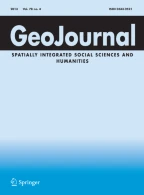201Accesses
47Citations
Abstract
The development of land-use structure during the Soviet period (1940–1991) has been analyzed. The main trends in land-use dynamics have been a decrease in the percentage of agricultural land and an increase in the share of forests. The most important driving factors of such a shift have been the land reforms of 1940, 1949 (collectivization followed by deportations), and 1989; and urbanization and concentration of agricultural production. Changes in land-use structure on the county level reflect well the socio-economic and political changes in Estonian society. An especially significant decrease in agricultural lands took place during the first ten years of collectivization. In coastal areas it has been combined with state political activities. Natural conditions also play an important role, particularly in local changes of land-use structure. The concentration of agricultural production, which is greater in the eastern part of Estonia (Upper Estonia), has caused many environmental problems. Likewise, land amelioration is one of the reasons for environmental disturbances. It has shifted agricultural activities from former arable lands to marginal areas (natural grasslands, wetlands). That is one of the reasons for nutrient cycling disturbances in agricultural landscapes. Despite many disturbances, Estonia has a well- developed network of ecologically compensating areas consisting of nature protection areas, forests, wetlands, and coastal waters. It is important to maintain this ecological network during privatization.
This is a preview of subscription content,log in via an institution to check access.
Access this article
Subscribe and save
- Get 10 units per month
- Download Article/Chapter or eBook
- 1 Unit = 1 Article or 1 Chapter
- Cancel anytime
Buy Now
Price includes VAT (Japan)
Instant access to the full article PDF.
Similar content being viewed by others
References
Data of the Estonian Land Cadastre 1990 (in Estonian)
Estonia: A & O. Entsüklopeediakirjastus, Tallinn 1993
Jagomägi, J.: Ecologically balanced land. Estonian Nature 26, 4, 219–224 (1983) (in Estonian with summary in English)
Juske, A.; Sepp, M.; Sihver, Ü.: Land amelioration activities between the two World Wars. In: Land amelioration. Estonian Ministry of Agriculture Information Centre, Tallinn 1991. (in Estonian)
Kasepalu, A.: That Which the Master Leaves, the Woods Will Take. Land use in the Estonian village. Tallinn 1991 (in Estonian with summary in English)
Land Balance of the Estonian SSR 1966. Tallinn 1967. (in Russian)
Land Cadastre of the Estonian SSR 1945–1985. Tallinn 1986. (in Estonian)
Lippmaa, T.: Main Features of Estonian Geobotany. Acta et commentationes Universitatis Tartuensis A XXVII, 4, 1–151 (1935) (in Estonian with summary in French)
Mander, Ü.: A possible method of determination of the simplification rate of ecological structure of land reclamation areas. Collection of Students' Scientific Works, pp. 77–82. Tartu 1978. (in Russian)
Mander, Ü.; Kuusemets, V.; Treier, K.: Groundwater quality dynamics of South Estonian agricultural landscapes. Proceedings of the GQM 93: Groundwater Quality Management, Tallinn, Estonia, 6–9 Sept. 1993. (in press)
Roosaare, J.: Determination of the diversity of the spatial structure of a territory. Collection of Students' Scientific Works, pp. 37–43. Tartu 1975. (in Russian)
Varep, E.: The Landscape Regions of Estonia. Publications of Geography IV. Acta et commentationes Universitatis Tartuensis 156, 3–28 (1964)
Yearbook of the Estonian Land Cadastre 1992. Tallinn 1993. (in Estonian)
Author information
Authors and Affiliations
Institute of Geography, University of Tartu, 46 Vanemuise Str., EE-240, Tartu, Estonia
Mander Ülo (Prof. Dr.) & Palang Hannes (Prof. Dr.)
- Mander Ülo
You can also search for this author inPubMed Google Scholar
- Palang Hannes
You can also search for this author inPubMed Google Scholar
Rights and permissions
About this article
Cite this article
Mander, Ü., Palang, H. Changes of landscape structure in Estonia during the Soviet period.GeoJournal33, 45–54 (1994). https://doi.org/10.1007/BF00810135
Published:
Issue Date:
Share this article
Anyone you share the following link with will be able to read this content:
Sorry, a shareable link is not currently available for this article.
Provided by the Springer Nature SharedIt content-sharing initiative

